 Leading Blog | Posts by Month |
 Leading Blog | Posts by Month |
01.31.20

LeadershipNow 140: January 2020 Compilation
See more on
Posted by Michael McKinney at 09:16 AM
01.29.20

Responsive Leadership: Needed Now More Than Ever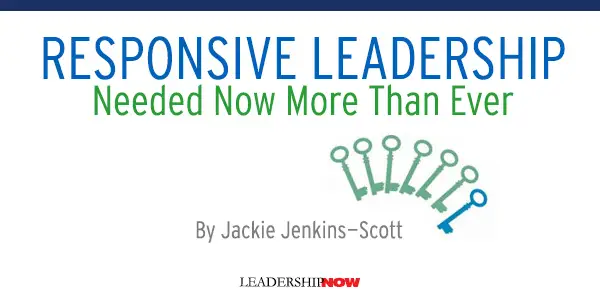
THE leadership question is top of mind for many people here in the United States and throughout the world. The idea that leaders are trustworthy, honest, and can be relied on to operate in the best interest of the public, the employee, the student, the parishioner, or even the shareholder has been shattered. No matter what industry or organizational structure—business, politics, nonprofit, religious, entertainment or sports—examples abound where leaders have violated their trusted role and experienced a public downfall. As a result, confidence in our leaders and the institutions they lead has diminished, sometimes to the point of no return. In these fast-paced, ever-changing, turbulent, and most stressful times, a major challenge that all leaders face is how to reduce skepticism and build greater trust and confidence in their role, their decisions, and in the organization they lead. In a recent LeadershipNow blog, Mark Sanborn wrote about six warning signs of why leaders fail: a shift in focus; poor communication; risk aversion; ethics slip; poor self-management; and lost love. Responsive Leadership can be an antidote to failing leadership and the foundation for building and sustaining organizational trust and confidence. What is responsive leadership? Responsive leadership focuses on the people—the humanity—within the organization to achieve organizational success. Often leaders are described by action words such as “results-oriented, innovative, driven and visionary”. Sometimes leaders are described by what they believe leaders do and how they approach their role, such as the systematic leader (leaders who use and rely on a set of methods and management tools) or the servant leader (a leadership philosophy in which the main role of the leader is as servant). Responsive leaders may employ these and other techniques, skills and actions all in service to a deep understanding and appreciation that the people within the organization underpin the organization in both triumph and crisis. Over my many decades in leadership roles, reflecting on my own development as a leader, talking with colleagues, and reading and studying leadership, I have come to believe that there are four essential attributes that drive the responsive leader. My selection of these leadership attributes was affirmed during a conference of corporate directors when over dinner, a few of us had a discussion about the attributes of strong and effective leaders. I call these attributes “The Big Four.” The Big 4 Leadership Attributes Curiosity: The Desire to Continuously Learn Curiosity will play a critical role in steering an organizational transformation, creating a new product, innovation or better understanding the competition. With a curious mind, the leader will seek knowledge and understanding from a variety of sources including outside experts, subordinates, peers, experts, and trusted advisors. By leading with curiosity, the leader will instill in the organization culture of continuous learning, a respect for and value for deeper understanding. A culture of continuous learning will bolster organizational creativity and innovation. Empathy: The Ability to Feel and Appreciate Other Human Beings The ability to understand feelings of others will keep us in touch with our own feelings as the organization tackles problems and finds solutions. Empathy is considered foundational to workplace cooperation and productive collaboration. In many work environments people must work with other people in order to be successful. Empathy will keep leaders tuned into the impact that the dramatic changes are having on the people around and in the organization. Regardless of leadership style, many executives would agree that empathy is a basic and very important quality of a successful leader. The ability to demonstrate empathy during crisis and challenging times will also help build trust and confidence in the leader and the decisions they are making. Humility: A Sincere Regard for the Reality that We Cannot Go It Alone Never underestimate the power of humility. Humility reinforces our curiosity in others and the world around us. Humility opens the door for a leader to have the courage to surround herself with the very best, people who are highly competent, and perhaps even smarter than herself. With humility, we know that we can learn from others, fully aware that “I” do not have all the answers. Employees will often respond most effectively to a “humble” leader. Another key ingredient to building trust and confidence in the leader and the organization. Resilience: The Capacity to Recover, to Keep Going Forward in the Face of Adversity All leaders face adversity at some point in their careers. Some of the hardest challenges to resilient leadership is rebounding from a setback. An important and necessary key for the resilient leader is “not to take it personally”, sometimes very hard to do. Recovering quickly from what you perceive as a failure and perhaps what everyone around you perceives as a failure can accelerate your own personal recovery process and as important, it can provide the ability for accelerated organizational growth and continued development. I believe each of the Big Four attributes—curiosity, empathy, humility, and resilience—are integral to responsive leadership and responsive leaders are needed today more than ever. Do you incorporate the Big Four in your leadership? And is it effective?  
Posted by Michael McKinney at 09:37 AM
01.27.20

Competing in the Age of AI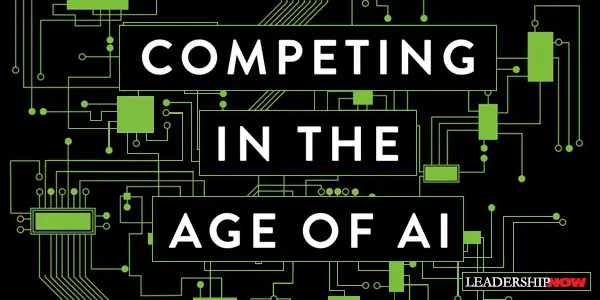
THE BIGGEST CHANGE being brought about by AI is not human replicas, but the emergence of digital operating models. These models aren’t the sexy, headline-grabbing side of AI, but they are profoundly affecting how we do business and the way leaders of the twenty-first century must think. Marco Iansiti and Karim Lakhani, professors at Harvard Business School, explore these changes in Competing in the Age of AI with examples of businesses in many industries. “When a business is driven by AI, software instructions, and algorithms make up the critical path in the way the firm delivers value.” And thus, how we think about the work we do and how we compete in the marketplace. The business plan describes the problem that is being solved for the customer—a reason to buy. The operating model is how that is accomplished. “The goal of the operating model is to deliver value at scale, to achieve sufficient scope, and to respond to changes by engaging in sufficient learning. If a business can grow in these areas it can increase its value. But here’s the thing. As these areas grow in a traditional business model, it also increases complexity and as a result, management challenges. At some point, the traditional model limits further growth. This is where AI is changing the nature of business and competition. With a digital operating model, “this new type firm is reaching new levels of scalability, achieving a vastly broader scope, and learning and adapting at a much faster rate than does a traditional firm. This is because the digital firm is transforming the critical path in the delivery of value.” This lengthy excerpt lays out the nature of the issue that leaders of traditional operating models face: Digital, AI-driven processes are more scalable than traditional processes. They enable greater scope (or variety), as they easily connect with a myriad of other digitized businesses, and they create powerful opportunities for learning and improvement, such as the ability to produce ever more accurate, complex, and sophisticated predictions and even gain fundamental understanding. In doing so, networks and AI are reshaping the operational foundations of firms, enabling digital scale, scope, and learning, and erasing deep-seated limits that have constrained firm growth and impact for hundreds of years. AI is breaking down the limits that are inherent in traditional operating models to drive new value, growth, and innovation. And when businesses with a digital foundation collide with more traditional firms, they can completely transform and reshape that industry. The authors provide case studies from the travel industry to the retail, entertainment, and automotive industries. The authors explain the issues faced when remaking a traditional operating model to exploit AI. They describe the journey to becoming an AI business. As we enter the age of AI, they point out five principles that we need to pay attention to: 1. Change Is No Longer Localized; It Is Systemic. “Inventions during the Industrial Revolution pertained to individual industries or at least clusters of industries. In contrast, digital transformation cuts across every industrial environment at the same time. Digital technology and AI are meeting an increasing variety of needs and enabling an incredible variety of use cases.” 2. Capabilities Are Increasingly Horizontal and Universal. “What is needed to compete in an AI-driven world has less to do with traditional industry specialization and more to do with a universal set of capabilities.” And this is especially important in a leadership context. “This new universality of capability reshapes a variety of operating tasks and reaches into strategy, business design, and even leadership. We are moving from an era of core competencies, differing from firm to firm and embedded deep in each organization, to an age shaped by data and analytics, powered by algorithms and hosted in the computing cloud for anyone to use.” 3. Traditional Industry Boundaries Are Disappearing Recombination Is Now the Rule. “The advice to executives in search of excellence was once to stick to their knitting and stay with businesses they knew. However, in the age of AI, organizations that cannot leverage customers and data across markets are likely to be at a disadvantage.” 4. From Constrained Operations to Frictionless Impact. “As digital operating models continue to displace traditional industrial processes, they also remove traditional operating constraints. This is why a new generation of firms has grown to unprecedented scale at unprecedented rates.” At the same time, even as frictionless systems “create unprecedented valuation multiples, digital scale, scope, and learning also create a slew of new leadership and governance challenges.” 5. Concentration and Inequality Will Likely Get Worse. In a pattern similar to what we saw in the Industrial Revolution, digital networks also lead to the “concentration of the flow of transactions and data, and from that to increased concentration of power and value.” All of this calls for—demands—a new degree of leadership wisdom. The implications of an AI-driven world are too complex and involve the exercising of values that only humans possess. Competing in the Age of AI is a fascinating book for not only implementing but understanding the transformations that are taking place in our digital world. 
Posted by Michael McKinney at 04:53 PM
01.24.20

Teaching By Heart: A Guide For Great Leadership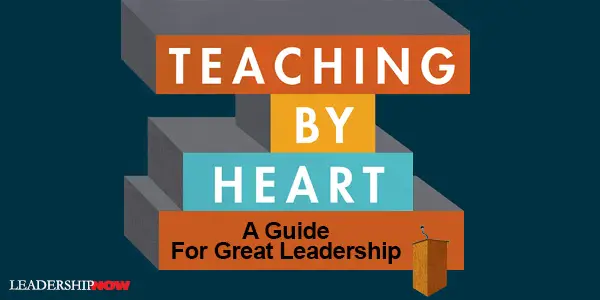
DESPITE what the title Teaching By Heart might imply, it is really a book about servant leadership. It is a journey into self-awareness so that you can serve those you lead or seek to influence in spite of your self-doubt, anxieties, and insecurities. It is a remarkable book and a perfect means to refocus your leadership development this year. Professor of management and organizational behavior at Harvard University, Thomas DeLong, writes, “I’ve found that the best teachers are also leaders, and the best leaders are also teachers.” I completely agree, and it is easy to see the parallels. Using himself as a case study, DeLong generously shares what goes on in his head and heart as a teacher. He shares what he has observed how in a teacher’s “best moments, they can life people up, and in their worst, let them down.” You will learn what it takes to teach and lead better. You will gain a better understanding of yourself. Through his introspection, you will come away with a better grasp of your own patterns of behavior. You will understand the need to ask yourself: “What is it that I do consistently that assists me living and teaching, that leverages my talents in unique ways? Just as important, you need to understand those emotional or behavioral patterns that sabotage your efforts to make a difference.” As teachers [and leaders], we focus more on our inadequacies and failures than on our strengths and accomplishments. I’ll deconstruct why this is so. I will walk you through the heaven and hell of teaching by dissecting and analyzing what I’ve experienced in the Harvard Business School classroom. After thirty-five years of teaching, DeLong still has anxiety about teaching. To counteract the doubt and anxiety on the days he teaches he must get into the classroom early. “Rather than listen to irrational thoughts and feelings, I need to engage with the ‘enemy.’ I need to look students in the eyes and engage. I need to get out of my head and be interested in something other than my thoughts and feelings and insecurities. The pattern that surfaces is he either/or syndrome. Will I leave the classroom with a feeling of either success or failure? So even if you aren’t a teacher who is wrapped up in your own doubt and insecurities, you should know what your patterns are—the tendencies and habits that either serve or disrupt your effectiveness.” “As the instructor, you need to increase the probability that your students will see and experience and feel what you want them to experience.” This doesn’t just happen. This is a challenge for teachers and leaders. Self-Awareness and Growth This self-awareness is a negative and a positive—a negative because it caused me to beat myself up continuously over my real and imagined shortcomings, a positive because it helped me become cognizant of my patterns. On Knowing Students I am freer as a teacher if I feel I know the students on some level, better able to adjust and adapt o their requirements. My hope is to turn their mindset from one of certainty to curiosity where their assumptions can be tested, confirmed, or revealed to be false.” The Power of Covenant versus Contractual Relationships As leaders, we create a covenant with those we lead. A covenant is a good way to think about a leader’s relationship with others. Three elements make up the covenant leaders make with their people. “I promise to set direction with you, to secure your commitment, and help you execute. If I do these things, you’ll succeed and so will the company. This is the covenant leaders establish with their employees, and it drives performance far better than salary and perks.” Teachers create this covenant with students in much the same way leaders do with employees. First, students must know that they are in safe, competent, understanding hands. The first dimension is built on faith. Contractual relationships are transactional. It’s all cognitive. “Contractual leaders and teachers worry about their image, how they are perceived by their boss—a manager or department head. They possess little empathy for others because their goal is to survive where they perceive themselves to be unwelcome.” Reflections The ideas expressed here are valuable to leaders in many roles—parents, teachers, pastors. One of my goals for the students is to have them stand back and face their own life path. An underlying assumption is that the students will do less harm if they are aware of why they do what they do. They will hurt themselves and others less if they understand the purpose and path they are on. I don’t pretend that they should have an answer, but I would like them to be asking questions about their journey before, during, and after the experience at HBS. Avoid Focusing on the Negative If we use external criteria to define success or happiness, we will come up short, given the powerful influence of our negative-remembering reflex. Everything gets distilled and reduced to one reflection or observation. The technical term for this cognitive process is asymmetric effect with a negative bias. It holds us captive in everyday life. Three Guiding Questions DeLong offers three guiding questions that will help guide our efforts to be authentic and genuine: 1. How do I experience others? What do we believe about others? The answer will inform how we interact with others. 2. How do others experience me? How do I portray myself to others? 3. How do others experience themselves when they are in your presence? Teaching By Heart is a very relatable book that all leaders should read. Leadership comes in many forms, but we all deal with the same issues. DeLong’s journey will help. 
Posted by Michael McKinney at 06:56 AM
01.22.20

What Robert Greifeld Can Teach You About Getting Your Organization On Track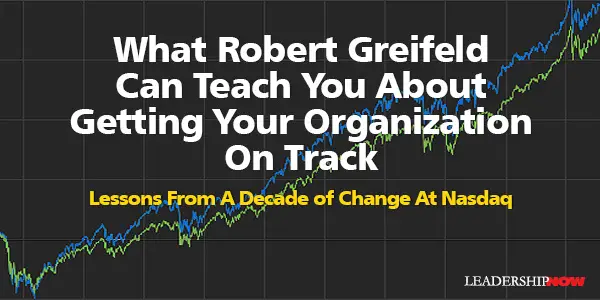
TURNING AROUND an organization requires a new story. A very clear and well-told story. When Robert Greifeld was asked to take the helm of Nasdaq in 2003 to execute a turnaround, he came with a new story. As he relates in Market Mover, the story had five parts: 1. Get the Right People on Board
In any cultural or business turnaround, the right people make all the difference. You can’t predict the future, so you need people that get the new story. You can’t control circumstances, but what you can do is to ensure that you have the best people in place so that when the world changes around them, they can adapt, respond, and step up. That’s why my motto has always been people first. He believes that you should promote before you recruit and offers this advice on finding them: Often, the people who are right for the new culture are not individuals who thrived under the previous regime. Change the culture, and inevitably, people with skill sets more apropos to the next context suddenly stand out. He wasn’t looking for just smart people, but people with bandwidth. That is, people with the “capacity to fruitful focus one’s attention on multiple areas.” He also encouraged debates among his executive team. The point of the debate wasn’t to enact a perfectly democratic ideal. It was to achieve better clarity on all of the issues involved so everyone understood the reasons for proposed changes, and my decision-making was both transparent and much better informed. Next, Greifeld had to get people working on the right things. “A common trait of those who fail, I believe, is that they end up working on the wrong things.” Prioritizing is the challenge. As a leader, I consider it my job to focus on what’s not working. Optimism is essential if you’re to take risks and succeed; indeed, it’s probably true that the only people who really accomplish things are the optimists. But that optimism must be tempered by a disciplined and critical perspective. A focus on cash is vital, but it’s important to remember that you can’t save your way to success. “When a culture is focused entirely on thrift, the next big thing is usually invented somewhere else.” To address the technology gap at Nasdaq, Greifeld went outside to buy winners—smart acquisitions. Today’s outsiders are tomorrow's establishment. Business leaders should always cultivate an attentive disposition toward outsiders, especially in industries impacted by technology. Always be on the lookout for new ideas, products, and technologies happening on the edges of your business ecosystem, where outsiders are developing a different picture of your future in apocryphal garages and basements. Naturally, Nasdaq must deal with regulation and government oversight, but no matter what business we are in, we must sell ideas to others. “Don’t feel like you’re above politics—none of us are. Learn to work with it and use it to increase your competitive advantage. Lobbying is education. It’s an opportunity to get important perspectives on the table so legislatures and regulators can actually make informed decisions.” Motivation to change is easier when you are threatened, but when times are good, when you have things where you want them, change is much harder. You always need to be looking for ways to change and grow. As NASDAQ grew and matured, Greifeld realized that he was not as essential as he had been. It was time to move on. He left the CEO position to someone he promoted when he first arrived, Adena Friedman. “Business is a marathon, not a sprint, and to be a leader in the marathon takes an unusual degree of fitness—mental, emotional, and physical.” Market Mover is of course, full of the nuts and bolts of financial technology and the digital economy, but it is so much more. It is not just about the revival of Nasdaq’s near-death experience but is a course in leadership and the entrepreneurial spirit that drives innovation and growth. He writes candidly of the most critical moments of his thirteen-year career at Nasdaq with each chapter focusing on a headline-making event. He takes us through his response and the lessons he learned. This book will not only help you be a better leader, but the insights you will find here will prove invaluable in guiding you as you build your organization. 
Posted by Michael McKinney at 02:35 PM
01.20.20

You Can Never Do Wrong, Doing Right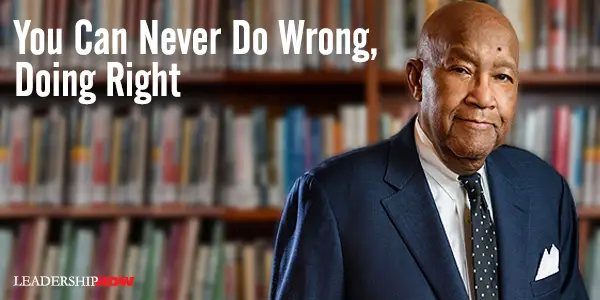
ON Martin Luther King Day, it is worth meeting a close friend of his, Robert J. Brown. Brown is the great-grandson of a slave. Raised by his grandmother in High Point, North Carolina, she used to tell him, “Bobby, do the right thing because you can never do wrong, doing right. You can’t go wrong.” And that has proven true for him over and over again. Although he grew up in poverty, his grandmother—he called her Mama—taught him about stewardship early on. Once when he was young, he asked her, “why do we give our food to these people who spend their days and nights drinkin’ and sleepin’ in the street when you and Daddy and Bill and me work so hard to put it on the table?” My question must have touched something in her. Mama waved for me to come up and sit in the chair with her. When I’d settled in, she told me a story from the Bible, of the time when Jesus knocked on someone’s door for help, but they turned Him away because He was dressed in rags. 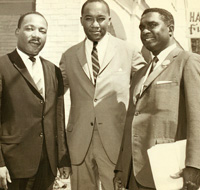 Sir Isaac Newton said, “If I have seen further, it is by standing on the shoulders of giants.” Great people stand on the shoulders of great people, and for Martin Luther King, Nelson Mandela and many others, Bob Brown helped make their success possible. His remarkable story is chronicled in his inspiring autobiography, You Can’t Go Wrong Doing Right: How a Child of Poverty Rose to the White House and Helped Change the World. 
Posted by Michael McKinney at 07:00 PM
01.17.20

The Power of Bad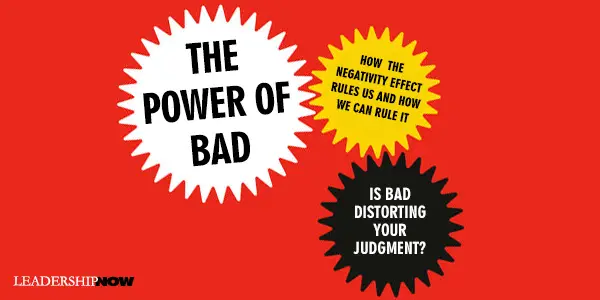
BAD gets into our head and it stays there leaving very little room for the good in our lives. We tend to focus on the bad, even in the face of a lot of positive things. Our brains are wired that way. It’s the negativity effect: the universal tendency for negative emotions and events to affect us more strongly than positive ones. John Tierney and Roy Baumeister (the first researcher to identify the negativity effect) describe the phenomenon well in The Power of Bad: We’re devastated by a word of criticism but unmoved by a shower of praise. We see the hostile face in the crowd and miss all the friendly smiles. The negativity effect sounds depressing—and it often is—but it doesn’t have to be the end of the story. Bad is stronger, but good can prevail if we know what we’re up against. Because of this, we have learned that it takes about four good things to overcome just one bad experience. It’s a rule of thumb, but it is useful to keep in mind when dealing with others and to understand our impact on those around us. “Being able to hold your tongue rather than say something nasty or spiteful will do much more for your relationship than a good word or deed.” Good relationships are more about what you don’t do. “Avoiding bad is far more important than doing good.” You don’t get much credit for going the extra mile, but you pay a big penalty for doing something bad. So how do we eliminate or a least minimize the bad? The negative? Not surprisingly, the more insecure you are, the more likely you are to act and think negatively. And our negative thoughts become a self-fulfilling prophecy dragging us deeper into the cynicism and doubt that undermines us. Negative thinking makes us small. Positive people “literally see a bigger picture. Their eyes sweep a wider field of vision instead of just focusing on what’s straight ahead, as they do when prompted with negative stimuli. Positive emotions broaden your perspective and enable you to build skills that help you flourish both personally and professionally.” We look for bad things. “Even when things are going your way, the amygdala keeps looking for the cloud behind the silver lining.” We create fears. They can become runaway trains that cripple us. When we do discover a fear, we need to put it in perspective. How important is it really? Rationally override the feeling by talking about it. How would you advise someone else in the same situation? Know what triggers your fear and calm yourself with coping statements. And breath. “A deep breath is a signal to the body that we’re safe.” Depressed people suffer from extreme negativity bias in the way they see themselves, the world, and the future. Depressed people focus relentlessly on their weaknesses and failures, ignoring their strengths and diminishing their successes as flukes. They interpret one setback as a fatal mistake and imagine it, leading to the worst possible outcome. Researcher Bethany Teachman says, “People with phobias want to avoid panic attacks, but that’s not the right goal to start with. The first goal is to stop caring whether or not you have a panic attack. A panic attack is uncomfortable but not dangerous. It’s a false alarm—a fear of fear. Once you make the decision to tolerate it, you get a sense of mastery, and eventually, the fear loses its power over you, and the panic attacks don’t come anymore.” What should we do when delivering bad news? Many think that the best thing to do is to deliver it gradually or after some good news, but research says most people would rather have the bad news first and straight. The criticism sandwich doesn’t really do what we hope it would because the “brain doesn’t logically process threatening information.” For praise or other good news to make a lasting impact, the brain must transfer it from the short-term working memory into long-term memory. This process gets disrupted when good news is followed by something negative. The brain uses so much energy to focus on the new threat that the previous pleasantness gets lost because of an effect called retroactive interference. If you have to deliver bad news or criticism, the authors recommend that first, consider your objective. Are you simply delivering bad news, or are you trying to get someone to change? When people heard first about their bad traits and then their good ones, they ended the experiments in a better mood, but they were also less inclined to do work to correct their bad qualities. The ones who heard the bad traits last were more worried but also eager for self-improvement. It’s not easy to motivate without demoralizing, but you can compromise by concentrating on the good feedback toward the end while also finishing up with a clear reminder of what's wrong and how to fix it. From there, the authors advise us, among other things, to ask questions, and then once we’ve gotten the criticism across, use the power of bad to your advantage. (Good insights on delivering criticism begin on page 99.) Hell motivates us more than heaven. Penalties for mistakes make us learn much more quickly than rewards. The fear of looking fat motivates us more to lose weight than the hope of looking slim. The advantage of penalties is that they are “so powerful that you often don’t have to use them. Rewards have to be doled out continually, but the mere threat of a penalty can make a lasting impact.” When bad things do happen to us, our response becomes the key issue. While many people experience a traumatic event in their lives, most—four out of five—trauma victims did not suffer from post-traumatic stress disorder (PTSD) afterward. “Instead of being permanently scarred, they underwent post-traumatic growth (PTG). Studies have found that more than 60 percent (sometimes 90 percent) of trauma victims undergo post-traumatic growth, including ones who initially showed symptoms of PTSD. Our response to life is everything. “The growth comes not from the trauma but from the way that people respond to it to become kinder, stronger, and more mindful of the joys in life.” When things do go wrong—and they will—force yourself to see it from another perspective. “People of all ages can counter the power of bad by consciously rewriting their narratives, focusing on their blessings, and savoring the good moments of their lives.” In 1841 Scottish journalist Charles Mackay published Extraordinary Popular Delusions and the Madness of Crowds. In it, he writes, “Men, it has been well said, think in herds. It will be seen that they go mad in herds, while they only recover their senses slowly, and one by one.” It’s up to each of us to see that good prevails. 
Posted by Michael McKinney at 07:34 AM
01.15.20

The Impact of Great and Terrible Leaders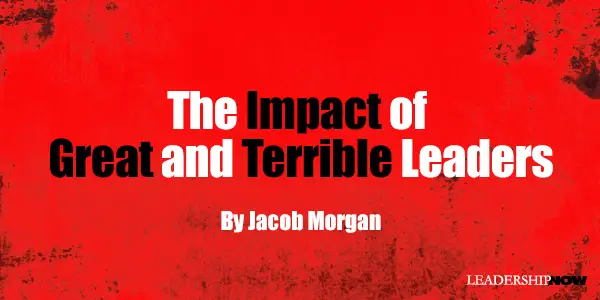
MOST PEOPLE have been around a bad leader at some point. Someone who doesn’t communicate, sets impossible expectations, or is just difficult to be around. You’ve likely experienced the draining, exhausting feelings from having to work with or for that person. Hopefully, most people have also experienced a great leader. These are the people who inspire and motivate and encourage people to do their best work towards a common goal. If you’ve experienced a bad leader and a great leader, you know the difference between the two can be night and day. But how do we turn those feelings into real action to develop great, future-ready leaders? What Makes a Great Leader? As part of my new book, The Future Leader, I interviewed more than 140 CEOs around the world and asked them each to define leadership. Their definitions were all over the board and included things like leaders being able to drive business success and reach goals to human skills like connecting with people and being humble. One of the main themes was that people believe a successful leader is someone who makes money and grows a business. The financial results definitely contribute to being a successful leader, but there is so much more that goes into becoming a truly great leader. Consider these two definitions from CEOs I interviewed. Judy Marks is the CEO of Otis Elevator and leads a team of over 70,000 employees around the world. According to Judy, “I think it’s really the ability to drive results, and I’ll leave that word results fairly generic. My role in terms of leadership is to set the vision and to share it. To create an environment where people can resonate not only with the mission but deliver it. To eliminate obstacles so my team can succeed.” Hans Vestberg is the CEO of Verizon Communications, an American multinational telecommunications conglomerate with over 152,000 employees around the world. Hans believes leadership is: “Ensuring that people have everything they need to achieve the missions of an organization. That’s it. All else is footnotes.” Which one most resonates with you and why? First and foremost, great leaders care about their people. They are willing to go the extra mile to serve and get the job done. A great leader knows that a company isn’t really successful if its numbers improve but its people aren’t happy. Leaders help shape the world and have a profound impact on their employees’ lives. If you’ve had the chance to work for a great leader, you know those lasting feelings: a great leader inspires you to be better, mentors you along the way, and gives you the tools to succeed. Great leaders help the people around them improve, even to the point that their employees are better equipped than the leader themselves. When individuals are motivated and engaged, they naturally want to work harder and better, which brings financial success. Impact of Great Leaders Great leaders create engaged employees who want to come to work and give their best effort. A study by Zenger Folkman found that good leaders can double company profits, simply with their ability to motivate and engage employees. Organizations with the highest-quality leaders are 13 times more likely to outperform their competitors. Another study found that how managers lead accounts for a 28% variance in employee job satisfaction. Any company would love to have an increase in employee satisfaction, and it’s as simple as putting great leaders into management positions. Great leaders also breed other great leaders. If you work for someone you admire and who displays great leadership skills, you’re more likely to also develop those skills and abilities. A great leader is like a pebble dropped in a pond who creates ripples of other good leaders all around them for years to come. What Makes a Bad Leader? On the flip side, a bad leader doesn’t care about people or creating an environment where employees want to improve and do their best work. Bad leaders often make their employees feel like cogs in the machine who are just there to clock in, do their job, and then clock out. Bad leaders often only care about the numbers or advancing their own career instead of creating a team mentality and moving the company towards success. Impact of Bad Leaders Employees who work for bad leaders often feel like their jobs are unenjoyable and meaningless. Studies have shown that working for a toxic leader leads to lower job satisfaction, which shouldn’t come as a surprise. But that lack of satisfaction carries over into other areas of employees’ lives. A study from the University of Manchester found that employees working for bad leaders or managers were more likely to experience clinical depression and over time became overly critical of their co-workers, took credit for each other’s work, and showed aggressive behavior to other people in the company. Clearly, the attitude of a bad leader isn’t contained in a single person. A leader sets the tone for the organization, which means their bad example and energy can spread through the entire organization and poison even good employees. Bad leaders cause employees to become disengaged in their work and are one of the biggest reasons for employees leaving their jobs. In many cases, employees don’t quit companies—they quit managers and bosses who are difficult to work for. A Gallup survey of more than 1 million employees found a staggering 75% of people who had quit their jobs had done so because of their boss and not the actual position. Developing Great Leaders There’s a stark contrast between good leaders and bad leaders. It’s often easy to point out bad leaders in past organizations or looking in from the outside, but it’s more difficult to make a change when you’re in the midst of working for a bad leader. Companies shouldn’t be afraid to overhaul their internal teams and processes to get rid of bad leaders. It’s impossible to only hire superstar leaders; organizations also need to learn how to develop people internally to create great leaders. Good leaders have a strong impact on the culture and overall success of the company. Investing in future leaders can have a large return as they motivate employees and help grow the company. Leaders have the potential to make a huge impact in their organizations. Great leaders can inspire employees, attract talent, and increase revenue, while bad leaders can create a toxic environment and drive away employees and customers. Organizations need to prepare for the future by identifying and removing bad leaders and then replacing them with strong leaders and an internal leadership development program. What kind of a leader are you and what kinds of leaders does your organization want to create?  
Posted by Michael McKinney at 07:54 AM
01.13.20

Helping People Change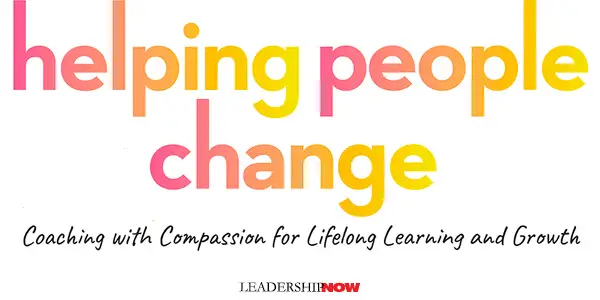
MOST OF US want to help people. And typically, we go about it by trying to correct a problem. We focus on what we think they should be doing. Makes sense. To us. But it frequently does not create sustainable change in the other person. Richard Boyatzis, Melvin L. Smith, and Ellen Van Oosten suggest a different approach in Helping People Change. Instead of coaching people for compliance, we should be coaching with compassion. The conventional view of coaching is that it is an activity where, “based on your experience, expertise, or authority, you advise individuals on what they should do and how they should do it. While there may be time and place for it, this type of coaching for compliance is unlikely to lead to sustained behavioral change.” When people change out of obligation, they often lack the inner motivation they need to sustain that change. For people to changes in ways that stick, that change has to connect with their passion and core values. To do that, you need to coach with compassion. Coaching with compassion is how we help a person frame the situation or opportunity in the context of who she wants to be as a person and what she would like to achieve in her ideal future. Such broad framing helps the person draw on the inner resources most likely to enable her to learn, change, or grow in the meaningful and sustained ways as she works through that situation, whatever it may be. The PEA Versus the NEA Coaching for compliance leads to a defensive response in the person being coached. They shut down and rather than learning or changing, they enter survival mode or what they term the zone of the negative emotional attractor (NEA). This is in contrast to coaching with compassion which elicits positive emotions as it focuses on a vision of a desired future state and strengths rather than weaknesses. This zone is called the positive emotional attractor (PEA). In this state, the person is relaxed and open, and new neural pathways form in the brain “paving the way for new learning, and sustained behavioral change to occur.” For sustained learning to occur, it is important that coaches manage the emotional flow of the coaching process. This means being able to both read and influence the emotions the person is experiencing. Getting people into a PEA state begins by asking the right questions. Questions that “discover their views of the word, their situation, and how they feel.” “Our mistake is in thinking—often assuming—that we can see what the other person should do to lead to a better life, be more productive, or learn more.” When we focus on the wrong things as a coach, we essentially block change. (Chapter 4 is the game-changer in this regard.) Three Cornerstones of Coaching Building a good relationship with the person you are coaching requires the right mindset. “First, believe that individual change is a process, not an event.” Change doesn’t happen overnight. We need to make room for mistakes, feedback, and more practice. “Second, consider your approach to coaching as a chance to mine for gold, not dig for dirt.” We need to connect with people’s strengths and their desired outcomes. At one time, Andrew Carnegie had 43 millionaires working for him. Carnegie was asked, "How did you develop these men to become so valuable to you that you have paid them this much money?" Carnegie replied that people are developed the same way gold is mined. When gold is mined, several tons of dirt must be moved to get an ounce of gold, but one doesn't go into the mine looking for dirt—one goes in looking for the gold. “Third, consider that the agenda for the conversation should come from the person being coached.” While the coach manages the process, “the fundamental reason for the process is to help the other person—not the coach to share his advice or experience.” It means listening more. This quote from gestalt psychotherapist Robert Lee is worth repeating every time we begin to work with others: “Our assumptions and stereotypes create filters for how we hear people. We don’t hear others from the place of who they are. We hear them through the filter of who we think they are.” When we coach for problem identification and problem-solving—as seems to make the most sense—we risk having the process becoming bogged down in negative emotions. “A problem-focused approach may seem efficient, but it ignores the fact that thinking about and arousing feelings about problems activates the NEA, which in turn can close a person’s imagination to new ideas and possibilities. Recognizing that a problem exists is quite different from spending a lot of time thinking and talking about it.” This book is invaluable not only for coaches but for leaders of all kinds—managers, parents, health care professionals pastors, and anyone who works with to guide others through life changes. The primary theme stressed throughout this book “is using personal vision to evoke positive emotions—essentially, to begin with the end in mind, thereby setting up the connections in the brain and emotions that will help us pave the road to the desired end.” 
Posted by Michael McKinney at 07:44 AM
01.09.20

The Future of AI: What Jack Ma and Elon Musk Are Missing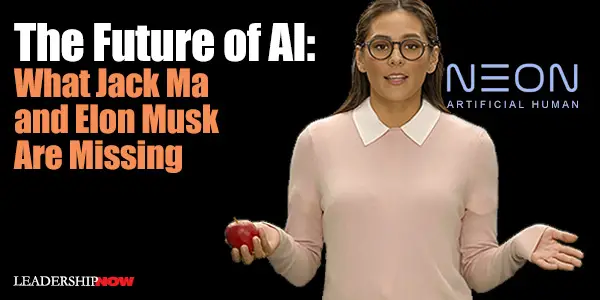
THERE IS LITTLE DOUBT that we underestimate the power of Artificial Intelligence. AI is quickly becoming a force in nearly every facet of human life. Serial Entrepreneur and Billionaire Elon Musk warns that AI will become much smarter than the smartest human. In a forum at the World Artificial Intelligence Conference held in China, on August 29, 2019, Elon Musk and Jack Ma exchanged differing views of the nature of AI. “There’s just a smaller and smaller corner of intellectual pursuits that humans are better than computers, and every year it gets smaller. Soon we will be far surpassed in every single way,” says Musk. Alibaba Group co-founder Jack Ma takes a different view. “When people talk about AI and say human beings will be controlled by machines—I never think that. It’s impossible. My view is that a computer may be clever. A human being is much smarter. Clever is very academic is knowledge-driven. Smarter is experience-driven.” Musk quickly disagreed. “Definitely not,” said Musk. “Computers are much smarter than humans on so many dimensions. The first thing you should assume is that we are very dumb and that we can definitely make things smarter than ourselves.” To which Ma responds, “Computer is only one of the collaborative tools that humans created. And computers are clever, but there will be more tools that human beings will create much cleverer than computers. “We invented the computer —I've never seen the computer invent a human being.” Ma is right: the creation is never greater than the creator. But even “clever” is not an attribute of a machine. Machines are not smart. They can access implanted memory faster and process data faster, but they are not smarter. Though they can be programmed to be and “learn” to be more lifelike, it is still artificial. Nevertheless, Musk’s concerns are warranted. Technology does outpace our ability to understand it and comprehend its consequences. Technology extends our reach, and most always, the intention is to make the world a better place. However, in every case, it is not the technology that is the issue, it is the people using it. What is always addressed too late is the character required to use it properly. Even with the basic AI we have today, we are seeing unprecedented changes that are beyond rendering certain skills and talents obsolete — they are reshaping what it means to be human. “If you assume any rate of improvement at all, the games will be indistinguishable from reality, you will not be able to tell the difference,” says Musk. And that is happening. At the Consumer Electronics Show this year, Samsung introduced the NEON project. Neons are like independent but virtual living beings that form memories and learn new skills, not AI assistants. Neons computationally create a “lifelike reality that is beyond normal perception to distinguish”—an artificial human. Isaac Asimov observes, “The saddest aspect of life right now is that science gathers knowledge faster than society gathers wisdom.” As AI increasingly impacts our lives, wisdom has become a fundamental leadership responsibility. It requires leaders to focus on character as a primary differentiator between man and machine.
Posted by Michael McKinney at 09:48 PM
01.01.20

First Look: Leadership Books for January 2020Here's a look at some of the best leadership books to be released in January 2020. Don't miss out on other great new and future releases.
Teaching by Heart summarizes the author's key insights gained from more than forty years of teaching and managing. It illustrates how teachers can both lift people up and let them down. It proposes that the best teachers are also leaders, and the best leaders are also teachers. In examining how to lead and teach, renowned Harvard Business School professor Thomas J. DeLong takes the reader inside his own head and heart. He notes that, as teachers, we often focus more on our inadequacies and missteps than on our strengths and unique talents. He explains why this is so by dissecting and analyzing his own experiences--using himself as a case study. The book's goal is to help readers learn about the intricacies of teaching and managing, and to impart lessons about how teachers can create a unique teaching atmosphere. To do this, the author analyzes the process of creating a curriculum, preparing for an eighty-minute class, managing the fifteen minutes before class begins, and evaluating the nature of the teaching experience after the session concludes.
A set of tools for mastering the one skill standing between us and success: the ability to ask for the things we need to succeed. Studies show that asking for help makes us better and less frustrated at our jobs. It helps us find new opportunities and new talent. It unlocks new ideas and solutions, and enhances team performance. And it helps us get the things we need outside the workplace as well. And yet, we rarely give ourselves permission to ask. Luckily, the research shows that asking—and getting—what we need is much easier than we tend to think.
One of the leading business thinkers in the world offers a bold, new theory of advanced leadership for tackling the world's complex, messy, and recalcitrant social and environmental problems. When traditional approaches are inadequate or resisted, advanced leadership skills are essential. In this book, Kanter shows how people everywhere can unleash their creativity and entrepreneurial adroitness to mobilize partners across challenging cultural, social, and political situations and innovate for a brighter future.
What is the greatest return on a leader’s time? After leaders have invested in their own leadership growth, what is the best way to accomplish their vision and grow their organizations? Develop leaders! The more leaders an organization has and the better equipped they are to lead, the more successful the organization and all of its leaders. In The Leader’s Greatest Return, Maxwell shares the most important lessons he’s learned about the leadership development process over the last quarter century.
Laura Huang, a preeminent Harvard Business School professor, shows that success is about gaining an edge: that elusive quality that gives you an upper hand and attracts attention and support. Some people seem to naturally have it. Now, Huang teaches the rest of us how to create our own from the challenges and biases we think hold us back, and turning them to work in our favor. In Edge, Huang offers a different approach. She argues that success is rarely just about the quality of our ideas, credentials, and skills, or our effort. Instead, achieving success hinges on how well we shape others' perceptions--of our strengths, certainly, but also our flaws. It's about creating our own edge by confronting the factors that seem like shortcomings and turning them into assets that make others take notice.
Are you a future-ready leader? Based on exclusive interviews with over 140 of the world's top CEOs and a survey of nearly 14,000 people. Do you have the right mindsets and skills to be able to lead effectively in the next ten years and beyond? Most individuals and organizations don’t even know what leadership will look like in the future. Until now. The majority of the world's top business leaders that Jacob interviewed believe that while some core aspects of leadership will remain the same, such as creating a vision and executing on strategy, leaders of the future will need a new arsenal of skills and mindsets to succeed.
 Build your leadership library with these specials on over 39 titles. All titles are at least 40% off the list price and are available only in limited quantities. “The more that you read, the more things you will know. The more you learn, the more places you’ll go.” — Theodore Geisel (aka Dr. Seuss)
Posted by Michael McKinney at 12:00 AM
|
BUILD YOUR KNOWLEDGE


How to Do Your Start-Up Right STRAIGHT TALK FOR START-UPS 
Grow Your Leadership Skills NEW AND UPCOMING LEADERSHIP BOOKS 
Leadership Minute BITE-SIZE CONCEPTS YOU CAN CHEW ON 
Classic Leadership Books BOOKS TO READ BEFORE YOU LEAD |
|